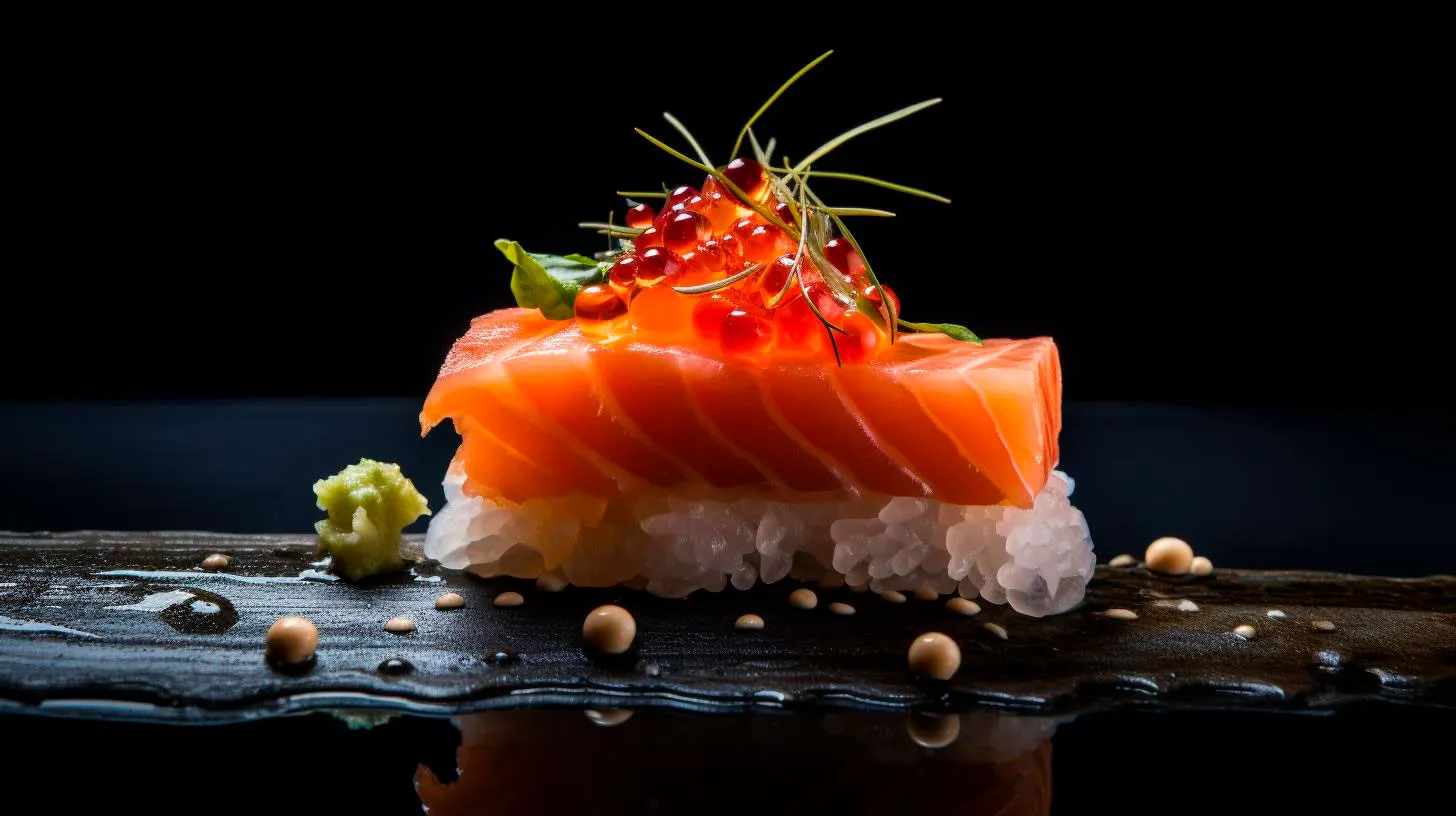Low-Carb Sushi Rolls: A Tasty Twist on Japanese Favorites
But fear not! In this article, we will explore the world of low-carb sushi rolls and discover how you can still indulge in this delicious Japanese favorite while staying on track with your dietary goals.
The Quest for Low-Carb Sushi
As awareness about low-carb diets has grown, so has the demand for healthier alternatives to traditional high-carb foods. Sushi lovers on restricted diets began exploring creative ways to make sushi rolls without rice. The result? A new wave of low-carb sushi options that are just as tasty as their carb-heavy counterparts.
So how do you make low-carb sushi without rice? You have a few options:
- Cauliflower Rice: Replace white rice with grated cauliflower, which resembles the texture of rice and has a mild flavor. Cauliflower rice is low in carbs and adds a nutritious twist to your sushi rolls.
- Nori Wraps: Skip the rice altogether and use nori sheets as a wrap instead. Nori is a seaweed sheet commonly used in sushi, and it adds a unique umami flavor while being naturally low in carbs.
- Vegetable Alternatives: Explore the world of vegetable sushi rolls by using ingredients like cucumber or zucchini as a replacement for rice. These options are not only low in carbs but also provide extra vitamins and minerals.
With these low-carb alternatives, you can enjoy sushi guilt-free and still satisfy your cravings for this beloved Japanese cuisine!
The Benefits of Low-Carb Sushi
Embracing low-carb sushi rolls brings a host of advantages to your dining experience and overall well-being. Here are some key benefits:
- Weight Management: By reducing your carb intake with low-carb sushi rolls, you can support your weight loss goals or maintain a healthy weight. These alternatives are generally lower in calories, making it easier to enjoy sushi without overindulging.
- Blood Sugar Control: For individuals with diabetes or those looking to stabilize their blood sugar levels, low-carb sushi rolls can be an excellent choice. The reduced carb content helps prevent blood sugar spikes.
- Increased Nutrition: Traditional sushi rolls often lack substantial nutritional value. However, low-carb options using vegetables or cauliflower rice provide additional vitamins, minerals, and fiber.
- Dietary Restrictions: Low-carb sushi is suitable for various dietary needs, including keto, paleo, and gluten-free diets. It enables individuals with specific dietary restrictions to enjoy sushi while staying compliant with their chosen eating plans.
By opting for low-carb sushi rolls, you not only satisfy your taste buds but also promote your overall health and well-being.
Exploring Low-Carb Sushi Fillings
Now that we know the secrets behind low-carb sushi rolls, let’s dive into exploring some delicious and nutritious fillings you can use:
1. Salmon and Avocado
The classic combination of fresh salmon and creamy avocado is a match made in sushi heaven. This filling is packed with heart-healthy fats, omega-3 fatty acids, and essential nutrients.
2. Tuna and Cucumber
For a refreshing flavor profile, try filling your low-carb sushi rolls with sliced tuna and crisp cucumber. Tuna is an excellent source of lean protein and essential minerals, while cucumber adds a satisfying crunch.
3. Shrimp and Mango
Add a tropical twist to your sushi rolls by combining succulent shrimp with sweet and juicy mango. This combination offers a delightful mix of flavors and textures, along with a dose of vitamin C and antioxidants.
4. Spicy Tofu and Spinach
If you prefer a plant-based option, try using marinated spicy tofu and vibrant spinach as your sushi filling. Tofu provides a good source of protein, while spinach delivers a range of vitamins and minerals.
These are just a few examples, and the possibilities are endless when it comes to low-carb sushi fillings. Get creative and experiment with your favorite ingredients to find combinations that suit your taste buds!
Key Takeaways
Low-carb sushi rolls offer a fantastic alternative for sushi enthusiasts who want to reduce their carb intake or follow specific dietary restrictions. Here are the main points to remember:
- Low-carb sushi can be made using cauliflower rice, nori wraps, or vegetable alternatives as substitutes for the traditional rice component.
- Enjoying low-carb sushi brings several benefits, including weight management, blood sugar control, increased nutrition, and compliance with various dietary needs.
- Experiment with fillings for your low-carb sushi rolls, such as salmon and avocado, tuna and cucumber, shrimp and mango, or spicy tofu and spinach.
- Let your taste buds guide you towards creating unique and delicious combinations while staying true to your low-carb goals.
So, the next time you’re craving sushi but want to keep it low-carb, don’t hesitate to try these incredible alternatives. Indulge in the artful and delicious world of low-carb sushi rolls, and enjoy a guilt-free dining experience!
Healthier Japanese Delights Elevating Your Sushi Experience
Let’s dive into the world of healthier Japanese delights that will take your sushi game to the next level.
1. The Rise of Vegan and Vegetarian Sushi
Recognizing the increasing demand for plant-based options, sushi restaurants have started offering a wide variety of vegan and vegetarian sushi rolls. These rolls feature creative ingredients like tofu, avocado, sweet potato, and cucumber, providing a burst of flavors and textures. Vegan and vegetarian sushi options not only cater to a diverse range of dietary preferences but also offer numerous health benefits such as improved digestion, reduced cholesterol, and increased intake of essential vitamins and minerals.
Key Takeaway:
- Vegan and vegetarian sushi rolls are becoming popular, catering to a diverse range of dietary preferences.
- These rolls feature creative ingredients, offering a burst of flavors and textures.
- Choosing vegan and vegetarian options can provide various health benefits.
2. Embracing Whole Grain Sushi
Traditionally, sushi is made with white rice, which is high in carbohydrates and lacks essential nutrients. However, sushi enthusiasts are now opting for healthier alternatives by embracing whole grain sushi. Whole grain sushi incorporates brown rice or other whole grains, which offer higher fiber content, essential fatty acids, and more micronutrients compared to white rice. This variation not only enhances the nutritional value of sushi but also provides a chewier texture and nutty flavor.
Key Takeaway:
- Whole grain sushi, made with brown rice or other whole grains, offers higher nutritional value compared to traditional sushi.
- This variation provides a chewier texture and nutty flavor.
- Whole grain sushi is rich in fiber, essential fatty acids, and micronutrients.
3. The Advent of Seafood Alternatives
As sustainability concerns rise, the sushi industry has seen a surge in seafood alternatives. Innovations like plant-based “tuna” and “salmon” made from ingredients like tomato, carrot, and soy protein have gained popularity. These seafood alternatives mimic the taste and texture of traditional fish, providing a guilt-free sushi experience for those who prefer to avoid consuming actual seafood. Additionally, these alternatives reduce the impact on marine ecosystems, making sustainable sushi a viable choice for conscious consumers.
Key Takeaway:
- Seafood alternatives made from plant-based ingredients are gaining popularity.
- These alternatives mimic the taste and texture of traditional fish.
- Sustainable sushi options reduce the impact on marine ecosystems.
4. Health-Boosting Additions: Superfood Sushi
Superfoods have become an integral part of healthy diets, and now they are making their way into sushi rolls. Adding ingredients like kale, quinoa, chia seeds, and matcha not only enhances the nutritional value of sushi but also introduces new flavors and textures. Kale, for example, is rich in vitamins, antioxidants, and fiber, while matcha offers a natural energy boost and is packed with antioxidants. These superfood additions elevate sushi from a delicious treat to a nourishing meal.
Key Takeaway:
- Superfoods like kale, quinoa, chia seeds, and matcha are being incorporated into sushi rolls.
- These additions enhance the nutritional value while introducing new flavors and textures.
- Superfood sushi provides an opportunity to enjoy a nourishing meal.
As the sushi industry continues to evolve, incorporating healthier and more diverse options, it’s important to embrace these changes and explore the wide range of flavors and benefits they have to offer. Whether you’re a sushi enthusiast or a health-conscious individual, these healthier Japanese delights are sure to elevate your sushi experience to new levels of enjoyment and well-being.
Sushi Reinvented: Exploring the World of Healthier Japanese Cuisine
Today, we delve into the world of healthier Japanese cuisine and discover the innovative ways in which sushi has been transformed.
The Rise of Health-conscious Sushi
As people become more health-conscious, the demand for healthier food options has increased. This has led to a considerable shift in the way sushi is prepared and consumed. Chefs and culinary experts have embraced this trend and started experimenting with alternative ingredients and techniques to make sushi both delicious and nutritious.
One of the key changes in reinventing sushi involves substituting white rice with healthier alternatives. Brown rice, quinoa, and even cauliflower rice have become popular choices in sushi rolls, providing a higher fiber content and lower glycemic index compared to traditional sushi rice. This change not only adds a nutty flavor to the sushi but also makes it suitable for individuals following gluten-free or low-carb diets.
Additionally, sushi fillings have also undergone a transformation. Alongside fresh seafood, vegetarian and vegan options have gained traction among health-conscious sushi lovers. Ingredients such as avocado, cucumber, tofu, and various types of mushrooms have made their way into sushi rolls, offering a range of flavors and textures that cater to different dietary preferences. These variations make sushi a versatile dish that can be enjoyed by everyone, regardless of their dietary restrictions.
Benefits of Healthier Sushi
Reinventing sushi brings a multitude of benefits that go beyond just the taste. Let’s explore some of the advantages of opting for healthier Japanese cuisine:
- Increased Nutritional Value: By incorporating whole grains, lean proteins, and nutrient-rich vegetables, healthier sushi provides a wider range of vitamins, minerals, and antioxidants.
- Improved Digestion: The higher fiber content in alternatives like brown rice and quinoa aids digestion, promoting a healthy gut and preventing digestive issues.
- Weight Management: As healthier sushi options are generally lower in calories and carbohydrates, they can support weight management efforts while still satisfying cravings.
- Diverse Flavor Profiles: Reinvented sushi brings a new world of flavors to the table. The combination of different ingredients creates unique taste profiles that enhance the overall dining experience.
Key Takeaways
Reinventing sushi has undoubtedly made Japanese cuisine even more appealing to a wider audience. Here are some key takeaways to remember:
- Sushi can be made healthier by substituting white rice with alternatives like brown rice, quinoa, or cauliflower rice.
- Health-conscious sushi includes a variety of fillings, catering to different dietary needs and preferences such as vegetarian, vegan, and gluten-free options.
- Healthier sushi provides increased nutritional value, improved digestion, weight management support, and diverse flavor profiles.
- Experimenting with different ingredients and flavor combinations enhances the sushi dining experience, promoting innovation in Japanese cuisine.
In conclusion, sushi has been successfully reinvented to align with the preferences of health-conscious individuals. The incorporation of healthier alternatives and a diverse range of fillings has allowed sushi to adapt and flourish in an ever-evolving culinary landscape. So, the next time you crave Japanese cuisine, remember to explore the world of healthier sushi options and savor the delightful flavors that await!
Nourishing Nigiri: Savoring the Benefits of Low-Carb Sushi
Nigiri sushi is a traditional Japanese dish consisting of bite-sized portions of rice topped with various ingredients, such as fish, seafood, or vegetables. What sets nigiri sushi apart from other sushi varieties is its simplicity and focus on showcasing the freshness and quality of the toppings. While traditional nigiri sushi uses rice, low-carb options replace the rice with healthier alternatives like cucumber or cauliflower rice, making it a great choice for those following a low-carb or keto diet.
The Benefits of Low-Carb Nigiri Sushi
Low-carb nigiri sushi offers numerous benefits beyond its delicious taste. Let’s explore some of them:
- Reduced Carb Intake: By substituting rice with low-carb alternatives, you significantly reduce your carbohydrate intake. This can be beneficial for individuals looking to manage their blood sugar levels, support weight loss, or follow a low-carb diet.
- Controlled Calorie Intake: Rice is a calorie-dense ingredient, and by eliminating or reducing it in your sushi, you can enjoy a lighter meal. This is particularly advantageous for those aiming to create a calorie deficit for weight management.
- Incorporate More Vegetables: Low-carb nigiri sushi often replaces rice with vegetables like cucumber or zucchini, providing an excellent opportunity to include more nutrient-packed vegetables in your diet.
- Increased Omega-3 Fatty Acids: Nigiri sushi usually features fish or seafood toppings rich in omega-3 fatty acids. These essential fats have numerous health benefits, including supporting heart health, reducing inflammation, and promoting brain function.
Key Takeaways for Nigiri Sushi Enthusiasts
If you’re intrigued by low-carb nigiri sushi, here are some essential takeaways to consider:
1. Get Creative with Toppings
One of the joys of nigiri sushi is its versatility, and the same applies to low-carb versions. Experiment with various toppings, such as salmon, tuna, shrimp, or even tofu, to find your favorite combinations.
2. Opt for Fresh and Sustainable Seafood
When selecting seafood for your nigiri sushi, prioritize fresh, sustainable options. Look for fish and seafood that is responsibly sourced to support the environment and ensure the best flavors.
3. Embrace the Crunch with Veggie Alternatives
Try replacing rice with thinly sliced cucumbers or grated cauliflower. These alternatives offer a satisfying crunch while reducing carb content, making your nigiri sushi both delicious and nutritious.
4. Enjoy the Health Benefits of Wasabi and Ginger
Wasabi and pickled ginger often accompany nigiri sushi. Not only do they add a kick of flavor, but they also offer potential health benefits. Wasabi may have antibacterial properties, while ginger is known for aiding digestion.
5. Balance Your Sushi Meal
Although nigiri sushi can be a healthy choice, remember to balance your meal with a variety of ingredients. Accompany your sushi with a side of miso soup and a fresh salad to ensure you’re getting a good mix of nutrients.
As the popularity of low-carb and keto diets continues to rise, low-carb nigiri sushi offers a delicious and satisfying alternative to traditional sushi. With its fresh ingredients, reduced carb content, and versatility, this dish provides a nourishing and guilt-free sushi experience.



